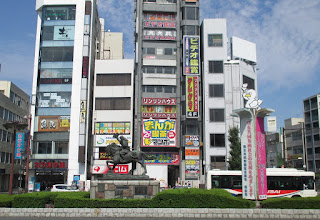Today’s walk was relatively long. I started from Okabe district of Fukaya City, visited Honjo, the 10th shukuba station in Honjo City, passed Kamisato Town in Saitama Prefecture, and went into Gunma Prefecture. I visited Shinmach shukuba station, Kuragano station and Takasaki, the 13th sukuba station. It was about 25 kilometer walk.
Large
fields of vegetables spread in the border area between Fukaya and Honjo cities.
They produce Welsh onion (famous as Fukaya negi), broccoli, and other products.
Tens of power transmission towers stand in the fields. There are many green
houses in the fields. They produce cucumber and other vegetables.
The
area locates between the Tone River and the Arakawa River. The land is rich and
much water is available (There was always a fear of water flood in the old
times).
It
is nearly 100 kilometers from the seashore (in Tokyo) here, but the altitude is
less than 100 meter. I reaffirmed how the Kanto Plane is wide.
Honjo
was the biggest shukuba station of Nakasend in the Edo period. Only few
historical buildings remain.
I
passed the border between Saitama and Gunma prefectures and moved into Shinmachi
station. It was built in the mid-17th century, about 50 years after the
open of other stations.
The
Nakasendo goes on the river bank of Karasu River between Shinmachi and
Kuragano. The river is a branch of the Tone River.
Transport boats went up to Suragano station in the Edo era. The boats carried goods between Edo and other regions.
Transport boats went up to Suragano station in the Edo era. The boats carried goods between Edo and other regions.
I
moved forward to the central part of Takasaki, where old Takasaki shukuba
station located. I found a boxed lunch factory along the road. They use the
daruma doll-shape lunchbox for the food. Takasaki is famous for the production
of the daruma doll.






















